
|
Hardware Product Review - Shotgun Microphones
|
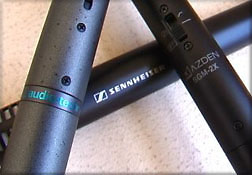 July 11, 2001
July 11, 2001
Low Cost Shotgun Microphone Comparison
Audio-Technica AT835b
Azden SGM-2X
Sennheiser K-6/ME-66/ME-67
Review by Dan Brockett
The Common Question
In order to supplement the amazingly high quality images that DV users are creating with low cost DV camcorders, many users are discovering during the editing process how important audio is in effectively telling their stories. Whether you produce documentaries, feature films, corporate communications or wedding videos, the quality of your soundtrack is what immediately quantifies your work with your audience. It's really pretty simple, bad audio equals amateurish, high quality audio equals professional.
Hopefully, this review will serve as the first in series of reviews in helping you assemble a decent quality, relatively low cost professional field audio kit for your productions. OK, now we're all in agreement that good audio is important, right? In case you haven't figured it out yet, the camcorder-mounted microphones that are standard issue on most DV camcorders are really about as useful as a breadstick in gathering high quality audio. Besides being mounted directly on the camcorder (a big no-no), the sound quality on the microphones that are included with most consumer/prosumer camcorders ranges from bad to worse. A logical first purchase for a field audio package is higher quality main microphone. Notice how I said "main" microphone? I have been asked many times about which microphone to purchase as "a good all-purpose" microphone. Truth be told, there is no such thing. Microphones are kind of like golf clubs, there are different types of clubs for different purposes and shots. Microphones are the same. More about this later. But in the meantime, a shotgun microphone is the best place to begin in assembling a versatile field audio package that will serve you well under 80 to 90% of the sound situations that occur on most projects. It's also one of the only pieces of a good field audio kit that you can begin to use immediately without many other pieces of support equipment, therefore increasing your audio quality as you build your field audio kit.
The First Step?
"Shotgun mic" is actually a generic term that has come to classify microphones of several types. The "shotgun" mic used to typically be a true condenser (externally powered) long microphone, but has now come to mean almost any long barreled microphone with a narrow acceptance angle.
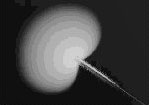
Cardioid
|
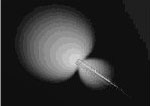
Super Cardioid
|

Lobar/Gun
|
These could include various types of mics termed by their manufacturers as "cardioid", "super cardioid", and "lobar/gun " as well as several other "creative" terms. In a typical field audio kit, the shotgun mic is typically the sound source for around 50 to 70% of what you hear actually ending up in the final mix for films and television. The reason is that, correctly used, a shotgun microphone will pick up the voices of the talent with a comfortable amount of the surrounding ambient sound. Unlike the sterile, close mic'd sound that is typical with a lavaliere microphone, the shotgun mic usually exhibits a fuller, richer and more pleasing sound quality. However, it is a mistake to think of a shotgun mic as a magical device that can only selectively pick up a specific sound while totally rejecting all sounds to the side or rear of the microphone. The way sound behaves is more complex than can be explained in this review, but suffice it to say, a shotgun mic is the correct tool for many audio tasks but it is not an all-purpose solution to every audio challenge. The shotgun mic is the logical place to begin in building a high quality field audio package.
Criteria For The Candidates
The purpose of our review was to examine and test shotgun microphones in a realistic price frame for most DV users, the majority of whom did not pay more than $3,500.00 for their DV camcorders. Most Canon GL-1 owners would not invest $2,000.00 for a high-end shotgun microphone because most DV users tend to view audio acquisition as an afterthought so reviewing high-end shotgun microphones like the Neumann KM82i or the Sanken CS5 that cost almost as much as the average DV camcorder was not an option for this review. Instead, we focused on the low end of the scale. How high quality is the sound reproduced from a $250.00 microphone? As compared to a $400.00 microphone? How much difference is there in the sound quality produced by these low cost units versus their higher priced cousins? Is the sound quality produced by these microphones good enough for television? Theater sound systems? How should these mics be used? We set out find out the answers to these questions and what we encountered in our tests may surprise you. We decided to review shotgun microphones available for a street price of between $250.00 and $400.00 and approached several microphone manufacturers.
Azden Corporation http://www.azdencorp.com provided us with a sample of their SGM-2X Microphone System.
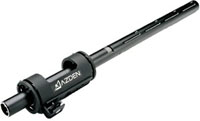
Audio-Technica http://www.audio-technica.com offered their AT835b shotgun.
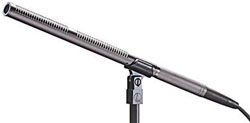
Sennheiser http://www.sennheiserusa.com provided the modular K6 power supply along with the ME-66 short shotgun capsule and the ME-67 long shotgun capsule.



An MCE86 S.1 shotgun mic was requested from Beyerdynamic for review http://www.beyerdynamic.com but the company refused to provide a test sample so that particular microphone was not reviewed here.
Typical Uses For Shotgun Microphones
After much discussion, we decided that most DV users would probably mainly use a shotgun microphone in one of three typical recording scenarios.
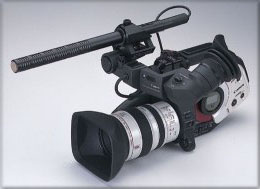
Camcorder Mounted
As the owner of a sound design/audio post facility, I cringe at the phrase, "camcorder mounted mic" but the facts of life are that many DV users do cover live event, documentary type situations, working alone without a sound recordist , and are specifically interested in how well a microphone mounted on their DV camcorder will perform. We tested all three microphones mounted on our Sony TRV-900 DV camcorder with a Beachtek Systems XLR adaptor plate and a Lightwave Systems http://www.lightwavesystems.com Universal Mini Mount with a two inch height extension to remove the tip of the mic from the upper portion of the picture. This extension is needed on most of the smaller camcorders but may or may not be necessary on a larger unit like a Canon XL-1 or Sony PD-150.
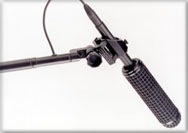
Boom Mounted
This is the preferred method of working with a shotgun mic and the method used in 90% of all professional work. The advantage is that the shotgun can be brought much closer to the talent or subject's proximity, thereby resulting in a much better signal to noise ratio, isolating the talent or subject's sound effectively from unwanted ambient sound while still retaining the richness and superior bass response that a shotgun records as compared to most other types of mics. The downside is that you must use a bigger crew, using the shotgun/boompole with at least with a boom operator/mixer or preferably, with a separate mixer and boom operator. It takes a crew of least two and preferably three to really work well with a single camera and a shotgun/boompole. We tested the microphones using a Lightwave Systems Universal Mini-Mount and Zeppelin mounted on a carbon-fiber Gitzo 11 foot boompole on a variety of shooting situations including informal "run and gun" setups, two camera sit down interviews and Steadicam "walk and talks". The mics were recorded through a PSC M4MkII four channel field mixer into several camcorders including a Sony TRV-900 using a Beachtek Systems XLR adaptor plate, a Sony DSR-500WS camcorder and a Canon XL-1 camcorder, as well as an HHB MDP-500 Professional Mini Disc recorder.
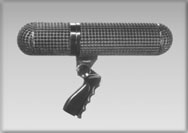 Sound and Sound Effect Gathering
Sound and Sound Effect Gathering
For this test, we plugged each microphone directly into the XLR inputs of an HHB MDP-500 Mini Disc recorder. The Lightwave Systems Universal mini mount and Zeppelin were detached from the Gitzo boompole and the mics were used with the handgrip for placement near various specific sound sources and also in and around various sound environments that would typically be recorded for ambient and sound effect gathering including several specific office sound effects, ambient sources including a children's playground, a shopping mall food court and several other locales.
So How Were They Different?
Here is where it got interesting. The Azden SGM-2X is actually a microphone system. When you purchase the SGM-2X, the kit includes a short barrel power supply/base, which is powered by a single "AAA" 1.5V battery as well as a long barrel capsule, which turns the system into a long shotgun mic. That's just the beginning though. Besides the long shotgun capsule, the kit includes short capsule which when combined with the power supply, results in an omni-directional cardioid mic. The kit also includes a long foam windscreen for the shotgun, a short foam screen for the omni cardioid configuration and a camera mounted universal shock mount. The kit even includes extra replacement "elastic bands" for the included shock mount. The system does not ship with a carrying case though. Very nice extras in this offering, especially considering that this mic was the second lowest price of the three units tested. No mention is made in the Azden owner's manual as to whether the SGM-2X can also be phantom powered from a mixer or camcorder's XLR jack.
The Audio-Technica AT835b is the company's low cost line+gradient condenser shotgun. The AT835b came in a nice plastic case and also included a long foam windscreen, a standard 5/8" mic mount (non-suspension) and the required "AA" 1.5V battery. The AT835b may also be phantom powered from any DC 9-52 volt system. The AT835b is not a mic system and is not expandable as are the two other systems we tested.
The Sennheiser K-6/ME-66/ME-67 is also a microphone system, much like the Azden SGM-2X. The K6 module is the power supply, the ME-66 is a short shotgun capsule and the ME-67 is a long shotgun capsule. Unlike the Azden, the Sennheiser system components must be purchased separately though. Just like the Audio-Technica, the K6 module includes a primitive (non-suspension) mic mount, the required "AA" 1.5V battery and a carrying case. The K6 power module can be powered by an internal "AA" 1.5 V battery or by external phantom power 12-48V from a mixer or camcorder. If for some reason, you would like to have the K6 powered only from phantom power with no option for "AA" battery power, the K6P is available and is only phantom powered. More on the significance of using the phantom power versus "AA" batteries later.
Below is a comparison table, detailing the features of each of the three mic systems.
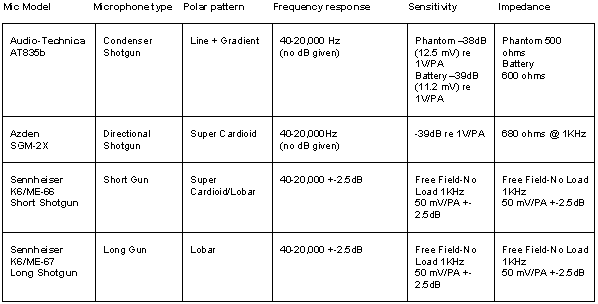
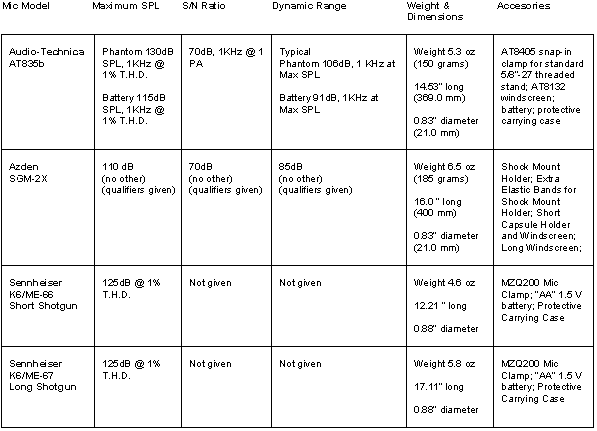
Profiles
Audio-Technica AT835b
$239.99 Street Price
Audio-Technica U.S., Inc.
1221 Commerce Drive, Stow, Ohio 44224
http://www.audio-technica.com
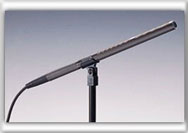 With a street price of just $239.99, the Audio-Technica was the least expensive mic we tested. According to Audio-Technica, "the AT835b is a wide-range condenser microphone with a line + gradient polar pattern designed to provide the narrow acceptance angle desirable for long distance sound pickup." Finished in matte, dark copper finish, the AT835b had a distinct, typically "Audio-Technica" look and feel. The tiny recessed bass roll-off control provides a 180 Hz, 12dB/octave roll-off. The location and design of this important control is a mixed blessing. It's impossible to accidentally turn on or off which is good for the field, but it also makes it exceedingly difficult to A/B compare the mic's sound with and without the bass roll-off. The overall look and feel of the AT835b is one of quality and the mic has the heft and feel of serious pro audio equipment. In our opinion, it is as difficult to quantify the sound qualities of microphones as it is to quantify the sound qualities of audio monitors. Listed below are several comments and observations about the sound qualities of the AT835b
With a street price of just $239.99, the Audio-Technica was the least expensive mic we tested. According to Audio-Technica, "the AT835b is a wide-range condenser microphone with a line + gradient polar pattern designed to provide the narrow acceptance angle desirable for long distance sound pickup." Finished in matte, dark copper finish, the AT835b had a distinct, typically "Audio-Technica" look and feel. The tiny recessed bass roll-off control provides a 180 Hz, 12dB/octave roll-off. The location and design of this important control is a mixed blessing. It's impossible to accidentally turn on or off which is good for the field, but it also makes it exceedingly difficult to A/B compare the mic's sound with and without the bass roll-off. The overall look and feel of the AT835b is one of quality and the mic has the heft and feel of serious pro audio equipment. In our opinion, it is as difficult to quantify the sound qualities of microphones as it is to quantify the sound qualities of audio monitors. Listed below are several comments and observations about the sound qualities of the AT835b
Camcorder Mounted
"At 14.5" long, this is pretty unwieldy on a camcorder like a TRV-900 or a GL-1. It works but is a little long."
"Nice isolation from shock and handling noise"
"Very precise sound with a lot of detail"
"Lower noise than the Azden"
"Sounds pretty clean for the least expensive mic"
"With the bass rolled off, I think it's too thin sounding"
Boom Mounted
"It say right in the literature not to
leave it in open sun or in areas where temperatures exceed 110 degrees F
for long periods of time or use it in high humidity areas. Kind of like
a Schoeps. Perhaps a little fragile or just their lawyers being
prudent?"
"Fairly directional with good rejection of off-axis noise"
"Doesn't react at all to handling noise on the boom pole. This is a mixed bag as it's nice but it also can indicate a lack of sensitivity"
Sound Gathering
"Very impervious to handling noise"
"Output seems right on par with the Azden."
"In looking over the frequency response, there is a definite bump at around 8-10KHz"
"Good for overly bassy environments"
"A little thin sounding for my taste"
If you think about it, this mic sounds pretty amazing for less than $240.00. A mic like this ten or fifteen years ago would have cost easily over $800.00 to have the same quality of build and sound. The AT835b comes from Audio-Technica with a standard one year parts and labor warranty. The unit is rated at 1200 ours of continuous use with a standard "AA" 1.5V battery or if you would like to use it as most professionals would, it will run happily on almost any phantom power source you care to feed it.
Azden SGM-2X
$249.99 Street Price
Azden Corporation
147 New Hyde Park Road
Franklin Square, N.Y. 11010
http://www.azdencorp.com
 With a street price of just $249.99, the Azden definitely seemed to be an outstanding value in comparison to the other mics we tested. The Azden included a short capsule and extra windscreen that basically turns your shotgun mic into an omni-directional cardioid. The fact that this is included in the $249.99 street price is quite impressive. The included shock mount is the inexpensive, "elastic band" type that frankly, doesn't do a really great job in isolating the mic from bumps and thumps as well as regular handling noise when camcorder mounted. We tested the Azden as well as the other mics with a LightWave Systems Universal Mini Mount that costs nearly as much as this mic, but it did make a huge difference in the sound quality during a typical session with camcorder movement. Although the extras included in the price are nice, we were most interested in the sound quality of the SGM-2X. Other than an informal listening, we didn't test the SGM-2X's omni cardioid capabilities as we felt that most prospective buyers would mainly care mostly about the performance of the shotgun configuration. The SGM-2X does feature an easy to adjust bass roll-off (200Hz 6dB/Octave) control as part of the main power switches operation. This made it much easier to A/B compare the sound with and without the mic's bass roll-off on the SGM-2X than with the other mic's tiny, recessed bass roll-off controls.
With a street price of just $249.99, the Azden definitely seemed to be an outstanding value in comparison to the other mics we tested. The Azden included a short capsule and extra windscreen that basically turns your shotgun mic into an omni-directional cardioid. The fact that this is included in the $249.99 street price is quite impressive. The included shock mount is the inexpensive, "elastic band" type that frankly, doesn't do a really great job in isolating the mic from bumps and thumps as well as regular handling noise when camcorder mounted. We tested the Azden as well as the other mics with a LightWave Systems Universal Mini Mount that costs nearly as much as this mic, but it did make a huge difference in the sound quality during a typical session with camcorder movement. Although the extras included in the price are nice, we were most interested in the sound quality of the SGM-2X. Other than an informal listening, we didn't test the SGM-2X's omni cardioid capabilities as we felt that most prospective buyers would mainly care mostly about the performance of the shotgun configuration. The SGM-2X does feature an easy to adjust bass roll-off (200Hz 6dB/Octave) control as part of the main power switches operation. This made it much easier to A/B compare the sound with and without the mic's bass roll-off on the SGM-2X than with the other mic's tiny, recessed bass roll-off controls.
Listed below are several comments and observations about the sound qualities of the SGM-2X
Camcorder Mounted
"This thing looks ridiculous on a DV camcorder. It's way too long"
"Great bass response even with the bass roll-off on"
"More 'grit' than either the Sennheiser or Audio-Technica"
"Sounds very 'rich and thick' to my ear"
Boom Mounted
"It's more directional than the Audio-Technica"
"Impressive rejection of off-axis noise"
"Fairly sensitive to handling noise"
"Good basic sound but not a lot of detail"
"I can actually hear some hiss with headphones on"
Sound Gathering
"I really like having the bass roll-off easy to access. There are times when you want to not use it and it's easier to decide whether to use the bass roll-off with this than with the others"
"The output level is decent but a little on the lower end"
"Good for thin sounding voices"
"Constructed OK but you can tell it's little a less expensive"
The SGM-2X can also be converted to a wireless mic unit although we generally avoid wireless mics like the plague unless we have to use them and we have never tested or used an Azden wireless. The SGM-2X comes from Azden with a standard two year parts and labor warranty. The lack of phantom power specifications (I didn't want to chance damaging the unit since it was on-loan) and the fact that the unit requires a "AAA" 1.5 V battery versus the two other brands which use the more common "AA" could be seen as a slight disadvantage. "AAA" batteries are easy to obtain, it's just that every other piece of audio gear seems to use "AA" size batteries so having to keep "AAA"s around as well could be a little inconvenient. This mic is rated at a 1,000 hour battery life from the single "AAA".
The testing staff seemed to be divided about half and half in regards to the sound quality of the SGM-2X. Half felt there was perhaps a little too much self-noise and distortion, while the other half of the testing staff liked the richness and bass response that the Azden seemed to provide that the other units tested seemed to lack. As stated previously, to us, the sound qualities of microphones are akin to audio monitors, each preference is very subjective depending on the listener's preferences.
Sennheiser K6 with ME-66 and ME-67 Shotgun Capsules
$379.99 Street Price for K6 power module and either capsule - $209.99 for extra capsule
Sennheiser USA
1 Enterprise Drive
Old Lyme, CT 06371
http://www.sennheiserusa.com



First, a little clarification is in order here. We tested the Sennheiser K6 with both the ME-66 short gun capsule and with the ME-67 long gun capsule. In our minds, the two capsules are two separate products with different applications. The Sennheiser combos were the most expensive mics we tested. The K6 with either capsule can be bought at a street price of $379.99 and the extra capsule can be picked up for a street price of $209.99. During our time testing the Sennheiser mics, it became apparent to us that if you need to mic more than one talent with one boom operator or if you are shooting in sound controlled environments like sound stages, the ME-66 had a very nice, open sound with medium rejection of off-axis noises. However, if you are shooting in practical locations or need more rejection of off-axis noise than the ME-66 or either of the other two mics tested here can provide, the ME-67 is a superior long shotgun. The construction the two units was typical of products from Germany, minimalist design with very high quality construction. So what does your extra approximately US $130.00 over either of the other two mics buy you? A slightly more refined sound quality with both the ME-66 and the ME-67, although at almost 18" long, the ME-67 was too long to practically mount on a mini DV camcorder in our opinion.
Listed below are several comments and observations about the sound qualities of the K6/ME-66/ME-67 (Each comment is marked as to which capsule was being used)
Camcorder Mounted
"This is the perfect size for a DV camcorder" (ME-66)
"Wow, in comparison to the other mics, this thing has twice the output level of the other two" (ME-66)
"This thing is way too long to use on a camcorder like this (TRV-900)" (ME-67)
"More bass than the Audio-Technica but less full then the Azden" (ME-66)
"This mic works great with the Lightwave Mount and the windsock" (ME-66)
"This is a great pickup for camcorder mounting. Less directional than the Azden or Audio-Technica" (ME-66)
Boom Mounted
"It's more directional than any other mic I've ever used except the 816T"(ME-67)
"It aims like a gun. Very directional" (ME-67)
"This mic has a very nice, smooth open quality. Perfect for two shots and flipping between the two talents" (ME-66)
"I have the recording levels on the camcorder at almost half of the level of the other two brands to get the same dB output. The output is very hot!" (ME-66)
"Very quiet and very little of the off-axis noise from the crew bleeds through. Great isolation" (ME-67)
Sound Gathering
"Without a doubt, the best overall sound of everything we tried" (ME-66)
"Picks up more detail like the whoosh of the lever on this L.E.D. clock" (ME-66)
"They call this a shotgun? It's almost more like an omni" (ME-66)
"Sennheiser makes great stuff. I love this for location or man-on-the-street stuff" (ME-67)
The K6 power module can also be converted to lavaliere mic unit as well as well as a PZM, omni-cardioid and a super cardioid. Very flexible. The K6 system comes from Sennheiser with a standard one year parts and labor warranty.
If you refer to the specs of most dual power system mics, you actually can obtain significantly better performance using phantom power rather than batteries if you have a mixer or camcorder with phantom power output. Everyone who used the K6 system seemed to be impressed with the overall sound quality. It was amazing how different the two capsules sounded and performed. It is nice to have both capsules for maximum flexibility in different shooting situations, but at close to $600.00, it becomes more of a luxury for users on tight budgets.
Cut To The Chase!
So now the question comes up, "which one (or two) to buy?". The good news is that with the right skills and technique, excellent results could be obtained from any of these mics. There was not a bad mic in the bunch. Just like audio monitors, much of the final choice comes down to personal preference.
If money is no object, (relatively speaking), the Sennheiser K6 with both the ME-66 and ME-67 capsules would be a great choice. Based upon this test, this is the system we are going to purchase for our own lower budget DV projects. I would encourage only users who will mostly shoot in sound controlled environments or users who want to camcorder mount a shotgun to go with the K6/ME-66 combo. If you typically are going to shoot in practical locations versus soundstages, the ME-67 would probably be a superior choice as far boom mounted work. The ME-67 is too long and has too narrow angle of acceptance to be useful as a camcorder mounted mic. In my opinion, the extra $130.00 is justified in higher quality sound and a little more elegant look and feel over the other two microphones. Don't forget though, with audio equipment, the law of diminishing returns applies. What this means is that as you go up in price, the quality of the product and the product's performance go up, but in incrementally smaller steps as the price range rises.
The Audio-Technica AT835b seems to be a great choice if you shoot in many bass heavy environments with high dB levels like live musical performances or have had problems with muddy mixes. The AT835b was rated for significantly higher dB levels than the other two units. The AT835b has a nice clear tone that many will find appealing and the quality and reputation are amazing for a $239.99 mic. An excellent value and a great choice for DV users who just cannot or will not spend $400.00 for a shotgun for their inexpensive DV camcorder but need better quality and more versatility than an on-camcorder mic can provide. No nonsense or frills but gets the job done nicely in the right hands. Not
tested here, but available from Audio-Technica are several variants of the AT835b, both longer and in stereo and also higher line, more expensive shotguns.
The Azden SGM-2X is a bargain hunters dream. It features decent sound and maximum versatility with the inclusion of the included omni directional cardioid mic at a $249.99 street price. Not to be overlooked is the Azden's standard two year warranty versus a single year on both of the other mics. Several of the testers liked the sound characteristics of the SGM-2X while, conversely, several felt that it had a little more self-noise and distortion than the Sennheiser or the Audio-Technica units. Once again, there is a matter of preference in sound characteristics. I would not recommend the Azden with high sound level projects as much as the other two mics since to my hearing, the SGM-2X distorted earlier than the other two mics with high sound levels. But for average level interview and dialogue work, the SGM-2X tended to slightly exaggerate proximity effect, which has the end result of warming up thin-sounding voices, which can be a big plus for weddings and corporate projects with "real people" who tend to not project their voices or have nasal or un-appealing voice qualities.
And now, to answer some questions I posed at the beginning of this review:
Q- How high quality is the sound reproduced from a $250.00 microphone? How much difference is there in the sound quality produced by these low cost units versus their higher priced "industry standard" cousins?
A- Surprisingly good. The sound reproduced from all of these microphones lacked the fine detail and the pickup from distance was limited in comparison to pricey offerings from Sennheiser, Schoeps, Neumann and Sanken but at less than 1/4 of the cost of most of the industry standard true condenser shotguns, the sound was quite good.
Q- The $250.00 mic's sound as compared to a $400.00 microphone?
A- Per my expectations, the $400.00 mic sounded better than the $250.00 mics. But ask yourself, "where and how will most of my work be reproduced?" If it's on mono VHS with a 2" speaker, the difference will probably not be apparent to your audience. If they cannot hear it, why pay for it?
Q- Is the sound quality produced by these microphones good enough for television?
A- For the most part, yes. I know that the Sennheiser K6 system is used by many news outlets and I have seen the Audio-Technica on some episodic and cable series sets. The Azden is fairly new to the market but I am sure that someone, somewhere is using it for television.
Q- What about in a feature for theater sound systems?
A- OK, let's get real here. We are talking low-end mics. They are amazing for the money but if it were my film or had my name on it as sound recordist, I would buy, rent, beg, borrow or steal to use a higher-end mic. Remember, in a theater, you have a lot more dynamic range, detail and sensitivity than even the best home theaters have so go for something a little better. But if these are all you can afford, (and you're doing a theatrical release project?), you could probably squeak by with these mics. But most of the nuances of the sync sound would be lost on a high dynamic range theatrical sound system. A good compromise would be to rent or purchase a Sennheiser MKH-70 or Neumann KM82i. But that's another article, right?
Hopefully, this review has been of help to you in selecting the best low cost shotgun microphone for your needs. In our next review article in the "Building A Field Audio Kit" series, we will take a look at the choices available for wired lavaliere microphones. Stay tuned for what promises to be another set of tough but fun choices.
Dan Brockett is a film and video director and co-owns a film and video production company, Big Little Films
tm,
Inc. and a sound design company, Noise Control
tm.
Dan is also a guide on the premier Final Cut Pro information
source, 2-Pop.com and he serves as Minister of information and Vice President of the Los Angeles Final Cut Pro Users Group.
Big Little Films, Inc.
2955 E. Hillcrest Drive, Suite 121 Thousand Oaks, Ca. 91362 USA
Office (805) 496 8130 Fax (805) 496 4027 E-Mail: BLFilms@earthlink.net
copyright © Dan Brockett 2001
All screen captures and textual references are the property and trademark of their creators/owners/publishers.
This article first appeared on lafcpug and is reprinted here with permission.
[Top]




July 11, 2001










Sound and Sound Effect Gathering


 With a street price of just $239.99, the Audio-Technica was the least expensive mic we tested. According to Audio-Technica, "the AT835b is a wide-range condenser microphone with a line + gradient polar pattern designed to provide the narrow acceptance angle desirable for long distance sound pickup." Finished in matte, dark copper finish, the AT835b had a distinct, typically "Audio-Technica" look and feel. The tiny recessed bass roll-off control provides a 180 Hz, 12dB/octave roll-off. The location and design of this important control is a mixed blessing. It's impossible to accidentally turn on or off which is good for the field, but it also makes it exceedingly difficult to A/B compare the mic's sound with and without the bass roll-off. The overall look and feel of the AT835b is one of quality and the mic has the heft and feel of serious pro audio equipment. In our opinion, it is as difficult to quantify the sound qualities of microphones as it is to quantify the sound qualities of audio monitors. Listed below are several comments and observations about the sound qualities of the AT835b
With a street price of just $239.99, the Audio-Technica was the least expensive mic we tested. According to Audio-Technica, "the AT835b is a wide-range condenser microphone with a line + gradient polar pattern designed to provide the narrow acceptance angle desirable for long distance sound pickup." Finished in matte, dark copper finish, the AT835b had a distinct, typically "Audio-Technica" look and feel. The tiny recessed bass roll-off control provides a 180 Hz, 12dB/octave roll-off. The location and design of this important control is a mixed blessing. It's impossible to accidentally turn on or off which is good for the field, but it also makes it exceedingly difficult to A/B compare the mic's sound with and without the bass roll-off. The overall look and feel of the AT835b is one of quality and the mic has the heft and feel of serious pro audio equipment. In our opinion, it is as difficult to quantify the sound qualities of microphones as it is to quantify the sound qualities of audio monitors. Listed below are several comments and observations about the sound qualities of the AT835b